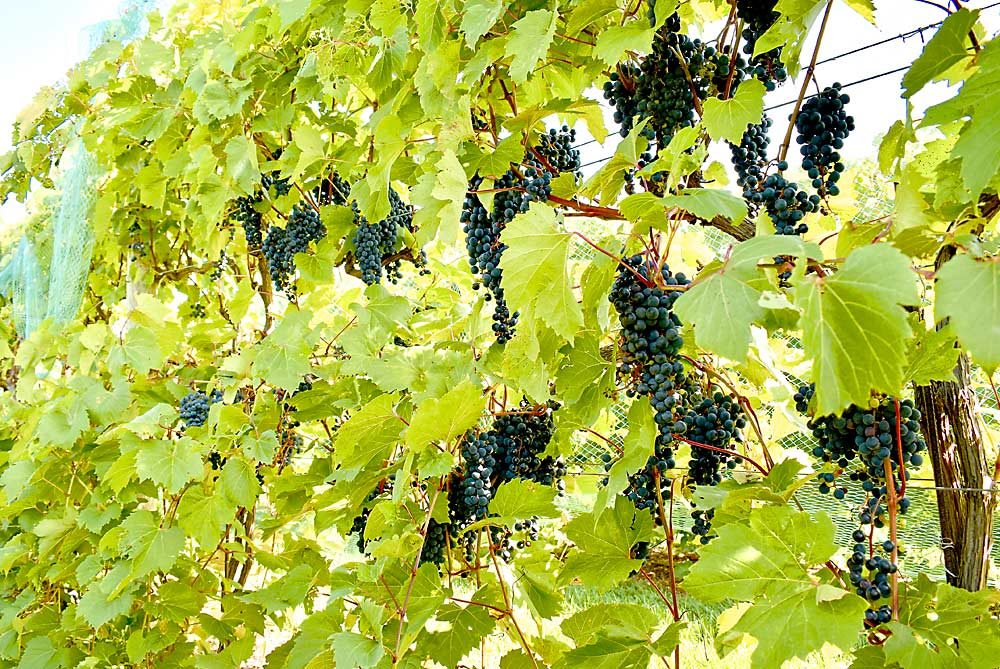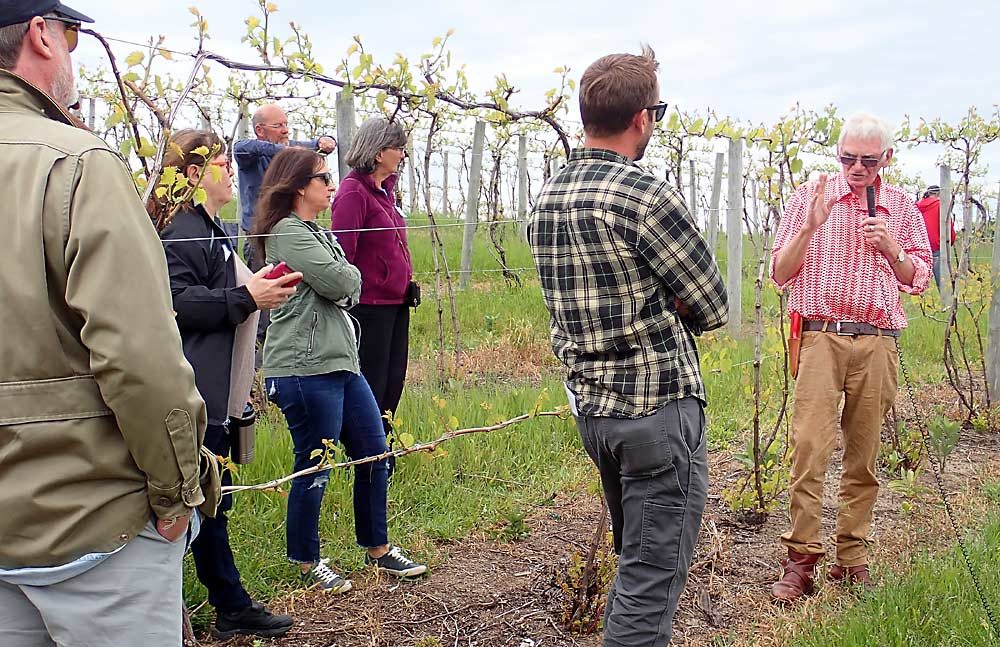
It’s as simple as the VSP, and you have more yield, better wine and less diseases. And you can mechanize it just as easily.
That is how renowned viticulture consultant Richard Smart of Australia described the Scott Henry trellis system, in comparison with vertical shoot positioning (VSP), while speaking to a group of Michigan growers last summer.
Growers told him they liked the ease of the VSP system, so Smart suggested they consider the Scott Henry system: It’s basically a VSP system with a mirror-image canopy growing below it. That second, downward-growing tier fills the space between the ground and the bottom of the VSP cane or cordon with a second crop.
It requires two fruiting wires, one set at the typical VSP height and fitted with the usual pair of canes or cordons, and the second fruiting wire about a foot lower, for a second pair. Clusters grow on both the upward and downward canopies, resulting in an increased crop load.
Smart said his experience in Australia shows that the two-tiered system meets key canopy management principles: sufficient leaf area, minimized shade, and a balance between shoot growth and fruit growth.
“Shade is the enemy of the modern viticulturist — it reduces yield, it reduces quality and it encourages some diseases,” he said. With Scott Henry, the vineyard becomes a well-run factory for turning sunlight into grape sugar, he said. And it accomplishes that with substantial yield increases; better color, flavor and phenolics; and reduced disease — when compared to VSP.

To find out whether Scott Henry, named after the Oregon grower who pioneered the system in the 1980s, is indeed a good choice for cooler climate vineyards, Good Fruit Grower spoke with three experts: Amaya Atucha, assistant professor and fruit crop specialist at the University of Wisconsin-Madison; Russell Moss, viticulture consultant, lecturer at Cornell University and grape grower/winemaker; and Michigan State University viticulture extension educator Thomas Todaro, who is stationed in the Northwestern Michigan wine region.
“Incredible results”
“We got pretty incredible results with Scott Henry,” said Atucha, who ran a six-year trial of three training systems — VSP, Scott Henry (using four cordons rather than canes), and high cordon — at a UW research station as part of the Northern Grapes Project. The trial included four colder climate hybrids: Frontenac, Marquette, Brianna and La Crescent.
“We got 50 percent more yield with Scott Henry than with VSP, and a good 30 to 40 percent more than with high cordon,” she said. The fruit quality was comparable to the other systems and, “with the benefit of having so much more yield on them, we had a considerable reduction in biomass or vigor of the vines.”
The reduction in vigor was a big benefit for the hybrids, which tend to be highly vigorous when grown in the rich, often rain-soaked soils of Wisconsin, she said. “It can really become a jungle when you grow on VSP, so growers spend so much time just doing shoot positioning and hedging those vines, (but) the Scott Henry really tamed them,” she said. In fact, they didn’t have to prune Scott Henry vines in the summer or spend time tucking shoots into the trellis.
The official trial ended in 2018, but Atucha is continuing to evaluate the Scott Henry system to see if it remains a solid performer. So far, it has.

“Every year, we have much higher yields, and we’ve never seen any difference in fruit chemistry,” she said. In Wisconsin, hybrids have no problems achieving Brix, but they can become overly acidic. By controlling vigor, Scott Henry canopies are more open and allow more sunlight to reach the clusters, she said, which lowers the acidity. “We ended up having to do less to get the levels of TA (total acidity) that we want to harvest those grapes,” she said.
Moss is similarly enthusiastic about the Scott Henry method.
“If you have VSP, and you need to leave more buds but don’t want to do spur pruning, then this makes sense. And in someplace like Michigan, where you probably don’t want to do spur pruning because you have freeze damage, this makes a lot of sense,” he said.
At a vineyard in Oregon, Moss sources fruit from a Scott Henry block for his award-winning luxury brand, Bocamo. Like Atucha, Moss has found that Scott Henry yields more grapes than VSP, lessens vigor, brings in more light and warmth to the clusters, and ultimately produces better wine. “In the Northeast and in the Midwest, I think there really is no drawback to go to Scott Henry,” he said.
Considerations
For Michigan growers, Todaro said Scott Henry is a good choice for high-vigor vineyards and early-season varieties, such as Chardonnay, and for warmer sites growing Pinot Grigio and Pinot Blanc. It’s also a good fit for sparkling wine production. That said, however, he noted that cluster thinning may be necessary to ensure sufficient ripening, especially during cool summers, such as this past season.
When it comes to hybrids in Michigan, he feels high cordon is the better option.
“It allows vine canopies to intercept more sunlight than those of VSP, in order to support a greater range of crop loads and therefore improved yield and ripening potential,” he said. “It is also an economical system that is well-suited to the natural downward shoot growth of hybrids.”
Moss and Todaro both noted that ripening in the Scott Henry system can be uneven for top versus bottom clusters.
“That’s not to say that they’re so far off that if you go out there with the machine, it’s going to be the difference between good and bad. It depends on your level of focus and your level of detail,” Moss said. “Because I do high-end luxury wines, the way I think about it is that I’m growing two different blocks in one block, so I sample the top and the bottom separately for ripeness and the way they taste, and I’ll take a crew out and (hand pick) harvest the top first, and usually about a week to 10 days later, harvest the bottom.”
In terms of overall labor needs, Moss said Scott Henry is comparable to VSP. “With Scott Henry, you have that added pass to flop the canopy down, but at the end of the day, you’re doing less shoot thinning because you have more buds per linear foot, so there’s less vigor-amelioration work,” he said.
In addition, the reduction in vigor decreases lateral shoot growth and canopy density, which lowers the incidence of fruit diseases. “You’re getting more sunlight to your fruit, which is killing off fungi; you’re drying off your fruit (more quickly); and you’re also getting more spray deposition to your fruit,” he said.
Given the litany of positive aspects for Scott Henry, Moss encouraged growers to give it a try on a small scale. “For me, I’ll try something new on a 1-ton lot, which is usually about a half-acre, see how I like it, ferment it and taste it blind if I’m doing a wine trial, so I don’t enter an unconscious bias,” Moss said.
“The expense for trying Scott Henry is very minimal,” he added. “It’s just the cost of a fruiting wire, some clips and maybe an additional catch wire and clips.”
Atucha agreed that it’s worth considering. “It works very well for us,” she said. “It’s just really a great training system.” •
—by Leslie Mertz






Leave A Comment